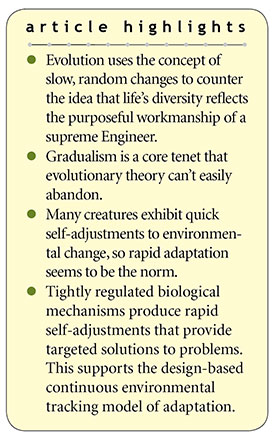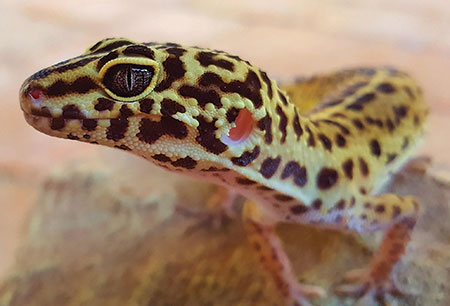 On April 13, 1970, an oxygen tank explosion on the Apollo 13 spacecraft thwarted its scheduled moon landing and threatened the crew’s ability to return home. The astronauts on board and engineers at the Kennedy Space Center had to quickly improvise a solution. Using duct tape, plastic bags, and other assorted items, they adapted the Command Module’s carbon dioxide removal system to fit the Lunar Module, providing a targeted solution to a critical problem. This rapidly devised lifesaving modification resulted in the rescue of the Apollo 13 astronauts in what has been called “NASA’s finest hour.”1
On April 13, 1970, an oxygen tank explosion on the Apollo 13 spacecraft thwarted its scheduled moon landing and threatened the crew’s ability to return home. The astronauts on board and engineers at the Kennedy Space Center had to quickly improvise a solution. Using duct tape, plastic bags, and other assorted items, they adapted the Command Module’s carbon dioxide removal system to fit the Lunar Module, providing a targeted solution to a critical problem. This rapidly devised lifesaving modification resulted in the rescue of the Apollo 13 astronauts in what has been called “NASA’s finest hour.”1
“Quickness” characterized the NASA engineers’ response to this perilous situation. Yet even without a crisis, an engineer’s typical approach to design modification is directed, rapid, and highly targeted since engineers are usually working under a deadline with finite resources. Could these same qualities also describe how living creatures respond to environmental challenges?
The Institute for Creation Research is developing an engineering-based, organism-focused model called continuous environmental tracking (CET) to explain how organisms self-adjust to changing conditions. Our model anticipates that the adaptive solutions creatures express can also be characterized as directed, rapid, and highly targeted. As we’ve highlighted in this Engineered Adaptability article series, research results are aligning with this expectation.
Our model anticipates that adaptive solutions creatures express can also be characterized as directed, rapid, and highly targeted. ![]()
The Words Characterizing Adaptation Matter
The way we describe adaptive results provides clues about whether we think the adaptations are purposefully produced by designed mechanisms or are just random outcomes. Evolutionary theory is fundamentally an anti-design framework that attempts to explain why creatures appear to be designed but really aren’t. The words that characterize evolutionary adaptations, then, ought to be the opposite of those used for an engineer’s purposefully designed solutions. Thus, evolutionary theory does not expect that adaptive outcomes can be described as tightly regulated, rapid, repeatable, sometimes reversible, and with highly targeted—even predictable—responses.
As we discussed in earlier articles,2 the eminent evolutionist Stephen Jay Gould emphasized that evolutionary theory “must” necessarily characterize both genetic variation and adaptation as undirected, copious, and small in extent—i.e., very gradual. “Undirected” obviously reflects evolution’s non-purposeful, chance-driven outcomes, but so does “copious.” When populations produce a huge number of potential solutions to environmental problems, this affords a haphazard “hit and miss” approach to problem solving—a blunt contrast with designed solutions that are typically characterized as “targeted.”
Why is gradual change needed to support the notion that adaptation is just a non-purposeful, random outcome? First, if an organism produces traits in response to an environmental challenge that are not only highly targeted solutions to the problem but also generate quickly rather than emerge gradually, then that might strongly indicate they’re the result of innate mechanisms that enable the organism to self-adjust to changing conditions. Such an outcome would be the opposite of non-purposeful or random.
Second, Darwinism is fundamentally about how nature’s randomly occurring deadly challenges to living creatures supposedly fraction out genetic variation to a few survivors without respect to a prior goal or future needs. This means that the evolutionary paths of organisms should meander aimlessly through time. Cumulative changes would naturally be gradual and highly unlikely to be repeated in other organisms. Insisting that genetic variation results from random mutations adds another non-purposeful element to Darwinism, making adaptive outcomes extremely unpredictable. Gradualism must be a core tenet of evolutionary theory to make it as anti-design as possible.
Evolutionary Theory Anticipates Slow Adaptive Rates
 The vast number of biological traits evolution must account for is one reason its pace is expected to be exceedingly slow. Per evolutionary theory, every protein, process, organ, and system is built by the gradual accumulation of extremely rare beneficial random genetic errors over millions of years. This expectation is summed up in the British Royal Society’s description of a themed issue of one of its journals:
The vast number of biological traits evolution must account for is one reason its pace is expected to be exceedingly slow. Per evolutionary theory, every protein, process, organ, and system is built by the gradual accumulation of extremely rare beneficial random genetic errors over millions of years. This expectation is summed up in the British Royal Society’s description of a themed issue of one of its journals:
Twenty-five years ago, science and society’s view of the pace of evolution was not that different from the one famously espoused by Darwin more than 100 years previously: “we see nothing of these slow changes in progress, until the hand of time has marked the long lapse of ages.”3
Gould references that same dictate by Darwin, but just before it he adds, “Substantial change might occur as a very rare event, but most alteration must be insensible, even on geologic scales,” by which he confirms that “gradualism may represent the most central conviction residing both within and behind all Darwin’s thoughts.”4 Thus, it seems that evolutionary theory cannot be conveniently stripped of gradualism without facing a severe loss of its potential to explain biological traits apart from design.
Gradualism is a powerful concept used to promote the acceptance of evolution. If someone asks why only adaptations have been observed but no real evolution, the pat answers from evolutionists conveniently claim that no one should expect to see it happen unless they could live for thousands of generations. If the notion of creatures evolving into fundamentally different beings is completely foreign to all human experience, so is the incomprehensively slow pace of evolution. This detachment from rational human experience opens the door for unbelievably fertile imaginations to contrive stories that extrapolate all kinds of evolutionary change. And through the wonder of imagination, the impossible becomes an evolutionary reality.
Yet, once again, reality does not cooperate with evolutionary theory. In spectacular contrast to expected gradualism, the British Royal Society’s journal description states, “Now, however, we have a completely different view: rapid evolution is occurring all around us all the time.”3
Reality: Rapid Self-Adjustments by Regulated Mechanisms
Not only do creatures’ biological responses happen quickly, the creatures also have characteristics that could enable them to closely track environmental changes. In Brazil, geckos were rapidly isolated from mainland counterparts and each other when a flooded reservoir created five new islands. Large geckos soon went extinct. Within 15 years, each island’s smaller gecko population ate larger prey and had independently adjusted to have notably bigger mouths and heads relative to body length. These findings “illustrate that populations can respond both rapidly, and in parallel, to ecological change.”5 Additionally, in what sounds like a case of environmental tracking, “rapid evolution has been recorded recently for several taxa, with rates of phenotypic change approaching, but not quite matching, rates of ecological change.”5
In another report, organisms appear to closely track temperature changes. Researchers studied several traits and genetics of the widespread grey-green lizard Anolis carolinensis in five habitats from southern Oklahoma to Mexico.6 Northern lizards were found to have a different expression of genes believed to support their better tolerance of cold weather. In the winter of 2013–2014, the southern United States experienced an extremely long and deep cold snap. Remarkably, springtime experiments on lizards at the Mexican border showed that they suddenly had greater cold tolerance and genetically “displayed shifts in gene expression predominantly toward mean expression levels of the northern-most population.”6
On 25 small islands in Florida, Anolis carolinensis, which lives freely from the bases of trees to their crowns, was invaded by another lizard, Anolis sagrei, a species that dominates the base area of trees. A. carolinensis relocated to a much higher perch. When researchers returned 15 years later, they discovered that sometime within 20 generations the A. carolinensis populations on all islands had developed larger toepads with a greater number of adhesive lamellae that improved their ability to cling to small branches.7
The snowshoe hare seems to closely track changes in daylight hours, temperature, and probably snow cover. Scientists in Montana are studying the hare’s seasonal molt of fur from brown to white and back again. One year had persistently cooler temperatures and heavier snow, and the researchers observed that “the completion date of the spring moult occurred 19 days later in 2011, consistent with the month longer snow duration in that year.”8
A study headed by Noah Reid concluded that “atlantic killifish populations have rapidly adapted to normally lethal levels of pollution in four urban estuaries.”9 In what sounds like an across-the-board, targeted response by killifish to environmental change, another report describes Reid’s findings as “strong evidence that adaptation has occurred rapidly and through similar genetic changes in multiple populations of killifish that have independently colonized polluted habitats.”10 Reid’s team found in killifish an example of what engineers construct: built-in systems that produce solutions to lethal problems upfront—since a gradual, iterative solution process would fail. Accordingly, Reid found that “standing genetic variation facilitated rapid adaptation to toxic environments by recruiting existing, beneficial genetic variants, avoiding potential time lags that could occur if evolutionary responses were dependent on de novo beneficial mutations.”10
Like killifish, trout already have the genetic information needed to successfully solve environmental challenges and rapidly fill new niches. Science reported:
Although we tend to think of evolution as happening over thousands, if not millions, of years, critical changes can take little more than a century. That’s what happened with a group of steelhead trout transplanted from the salty seas of California to the fresh waters of Lake Michigan for game fishermen in the 1890s.11
ICR recently reported several more examples of how organisms rapidly self-adjust to conditions changed by humans and cited a leading researcher who noted these adaptations are “occurring all around us all the time” and that “in many cases, these effects play out over only a few years to decades—more quickly than biologists traditionally thought possible”12
A Design-Based Model Like CET Expects “Warp Speed” Self-Adjustments
As indicated earlier, gradualism is a major tenet of evolutionary theory. The pace of evolution was never supposed to be characterized as rapid. So, imagine the response of schoolchildren indoctrinated in this belief if they were made aware of this eye-popping headline in the science journal Nature: “How warp-speed evolution is transforming ecology: Darwin thought evolution was too slow to change the environment on observable timescales—ecologists are discovering that he was wrong.”13 This article shows how evolutionists readily swallow findings that totally contradict their theory and then keep them concealed from students for decades:
“Everybody realized rapid evolution was occurring everywhere,” says evolutionary ecologist Andrew Hendry of McGill University in Montreal, Canada.…Darwin never imagined seeing this in action, because he thought that evolution occurs only at the “long lapse of ages.” But by the late 1990s, ecologists had started to realize that evolution could be observed within a few generations of a given species.13
A theory of adaptation that requires changes to be undirected, copious, and small in extent has no room for explanations of such rapid responses to environmental challenges. However, if organisms closely track environmental changes with the same elements used in human-designed tracking systems, then we would expect their self-adjustments to be characterized as very quick or even “warp speed” and “occurring everywhere.” We have seen that creatures’ adaptive solutions have been characterized as “directed” and “highly targeted,”2 and now as “rapid.”
Evolutionists readily swallow findings that totally contradict their theory and then keep them concealed from students for decades. ![]()
The only difference between the solutions produced by creatures and NASA engineers is in the degree of complexity. Of all people, engineers should appreciate great feats of engineering. The best engineers responsible for NASA’s finest hour should say of their Designer, the Lord Jesus Christ, “O Lord, how great are thy works! Your thoughts are very deep” (Psalm 92:5).
Click here for other articles in the Engineered Adaptability series.
References
- Seil, B. NASA’s Finest Hour: Sy Liebergot recalls the race to save Apollo 13. Boeing News Now. Posted on July 5, 2005.
- Guliuzza, R. J. 2018. Engineered Adaptability: Adaptive Changes Are Purposeful, Not Random. Acts & Facts. 47 (6): 17-19; Guliuzza, R. J. 2018. Engineered Adaptability: Adaptive Solutions Are Targeted, Not Trial-and-Error. Acts & Facts. 47 (7): 18-20.
- Human influences on evolution, and the ecological and societal consequences. Philosophical Transactions of the Royal Society B. Posted on rstb.royalsocietypublishing.org.
- Gould, S. J. 2002. The Structure of Evolutionary Theory. Cambridge, MA: Belknap Press, 147-148.
- de Amorim, M. E. et al. 2017. Lizards on newly created islands independently and rapidly adapt in morphology and diet. Proceedings of the National Academy of Sciences. 114 (33): 8812-8816.
- Campbell-Staton, S. C. et al. 2017. Winter storms drive rapid phenotypic, regulatory, and genomic shifts in the green anole lizard. Science. 357 (6350): 495-498.
- Stuart, Y. E. et al. 2014. Rapid evolution of a native species following invasion by a congener. Science. 346 (6208): 463-466.
- Zimova, M. et al. 2014. Snowshoe hares display limited phenotypic plasticity to mismatch in seasonal camouflage. Proceedings of the Royal Society B. 281 (1782): 20140029.
- Reid, N. M. et al. 2016. The genomic landscape of rapid repeated evolutionary adaptation to toxic pollution in wild fish. Science. 354 (6317): 1305-1308.
- Tobler, M. and Z. W. Culumber. 2016. Swimming in polluted waters. Science. 354 (6317): 1232-1233.
- Pennisi, E. This saltwater trout evolved to live in freshwater—in just 100 years. Science. Posted on sciencemag.org June 1, 2018, accessed June 1, 2018.
- Guliuzza, R. J. Fast Evolution Confirms Creationist Theory. Creation Science Update. Posted on ICR.org January 16, 2017, accessed June 26, 2018.
- Lallensack, R. How warp-speed evolution is transforming ecology: Darwin thought evolution was too slow to change the environment on observable timescales. Ecologists are discovering that he was wrong. Nature News. Posted on nature.com January 31, 2018, accessed February 2, 2018.
* Dr. Guliuzza is ICR’s National Representative. He earned his M.D. from the University of Minnesota, his Master of Public Health from Harvard University, and served in the U.S. Air Force as 28th Bomb Wing Flight Surgeon and Chief of Aerospace Medicine. Dr. Guliuzza is also a registered Professional Engineer.





















